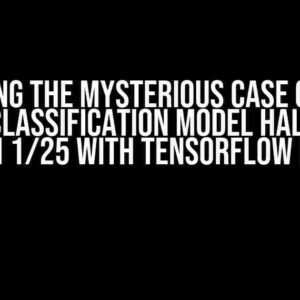Are you tired of waiting for your model to finish training before you can infer the results? Do you want to monitor the performance of your model at every epoch during training? Look no further! In this article, we will show you how to infer every epoch during training by loading the current weight with an instantiated new model with a specified input shape.
Why Infer Every Epoch During Training?
Inferencing every epoch during training can be beneficial in several ways:
- Monitor Model Performance: By inferencing every epoch, you can monitor the performance of your model and see how it improves over time.
- Early Stopping: You can stop training early if the model’s performance stops improving, saving you time and computational resources.
- Hyperparameter Tuning: Inferencing every epoch allows you to tune hyperparameters more effectively, as you can see the impact of changes on the model’s performance.
Prerequisites
Before we dive into the implementation, make sure you have the following:
- A deep learning framework such as TensorFlow, PyTorch, or Keras.
- A trained model (or a model in the process of being trained).
- A dataset to infer on.
Step 1: Instantiate a New Model with Specified Input Shape
The first step is to instantiate a new model with the same architecture as the original model, but with a specified input shape. This new model will be used for inferencing every epoch during training.
# Import necessary libraries
import tensorflow as tf
# Define the input shape
input_shape = (224, 224, 3)
# Instantiate a new model with specified input shape
new_model = tf.keras.models.Sequential([
tf.keras.layers.InputLayer(input_shape=input_shape),
tf.keras.layers.Conv2D(32, (3, 3), activation='relu'),
tf.keras.layers.MaxPooling2D((2, 2)),
tf.keras.layers.Flatten(),
tf.keras.layers.Dense(128, activation='relu'),
tf.keras.layers.Dropout(0.2),
tf.keras.layers.Dense(10, activation='softmax')
])
Step 2: Load Current Weight into New Model
The next step is to load the current weight of the original model into the new model. This is done by using the `set_weights()` method.
# Load the current weight of the original model
original_model_weights = original_model.get_weights()
# Load the current weight into the new model
new_model.set_weights(original_model_weights)
Step 3: Infer on the Dataset
Now that the new model has the current weight of the original model, you can use it to infer on the dataset.
# Compile the new model
new_model.compile(optimizer='adam', loss='categorical_crossentropy', metrics=['accuracy'])
# Infer on the dataset
predictions = new_model.predict(dataset)
Step 4: Repeat Steps 2-3 Every Epoch During Training
To infer every epoch during training, you need to repeat steps 2-3 every epoch. You can do this by adding a callback function to your training loop.
# Define a callback function to infer every epoch
class InferCallback(tf.keras.callbacks.Callback):
def on_epoch_end(self, epoch, logs=None):
# Load the current weight into the new model
new_model.set_weights(self.model.get_weights())
# Infer on the dataset
predictions = new_model.predict(dataset)
# Print the inference results
print(f'Epoch {epoch+1}, Accuracy: {logs["accuracy"]:.2f}')
# Add the callback function to the training loop
original_model.fit(dataset, epochs=10, callbacks=[InferCallback()])
Example Code
Here’s an example code that puts it all together:
import tensorflow as tf
# Define the input shape
input_shape = (224, 224, 3)
# Define the original model
original_model = tf.keras.models.Sequential([
tf.keras.layers.InputLayer(input_shape=input_shape),
tf.keras.layers.Conv2D(32, (3, 3), activation='relu'),
tf.keras.layers.MaxPooling2D((2, 2)),
tf.keras.layers.Flatten(),
tf.keras.layers.Dense(128, activation='relu'),
tf.keras.layers.Dropout(0.2),
tf.keras.layers.Dense(10, activation='softmax')
])
# Compile the original model
original_model.compile(optimizer='adam', loss='categorical_crossentropy', metrics=['accuracy'])
# Instantiate a new model with specified input shape
new_model = tf.keras.models.Sequential([
tf.keras.layers.InputLayer(input_shape=input_shape),
tf.keras.layers.Conv2D(32, (3, 3), activation='relu'),
tf.keras.layers.MaxPooling2D((2, 2)),
tf.keras.layers.Flatten(),
tf.keras.layers.Dense(128, activation='relu'),
tf.keras.layers.Dropout(0.2),
tf.keras.layers.Dense(10, activation='softmax')
])
# Define a callback function to infer every epoch
class InferCallback(tf.keras.callbacks.Callback):
def on_epoch_end(self, epoch, logs=None):
# Load the current weight into the new model
new_model.set_weights(self.model.get_weights())
# Compile the new model
new_model.compile(optimizer='adam', loss='categorical_crossentropy', metrics=['accuracy'])
# Infer on the dataset
predictions = new_model.predict(dataset)
# Print the inference results
print(f'Epoch {epoch+1}, Accuracy: {logs["accuracy"]:.2f}')
# Add the callback function to the training loop
original_model.fit(dataset, epochs=10, callbacks=[InferCallback()])
Conclusion
In this article, we showed you how to infer every epoch during training by loading the current weight with an instantiated new model with a specified input shape. By following these steps, you can monitor the performance of your model at every epoch and make adjustments as needed. Remember to adjust the hyperparameters and the callback function according to your specific use case.
| Keyword | Infer Every Epoch During Training with Load Current Weight with Instantiate New Model with Specified Input Shape |
|---|---|
| Difficulty Level | Advanced |
| Estimated Time to Implement | 30 minutes – 1 hour |
| Prerequisites | Deep learning framework, trained model, and dataset |
Happy training!
Frequently Asked Question
Get the inside scoop on inferencing every epoch during training with loading current weights and instantiating a new model with a specified input shape.
Q1: What’s the point of inferencing every epoch during training?
Inferencing every epoch during training allows you to monitor the model’s performance on a validation set and adjust the hyperparameters accordingly. This ensures that the model is learning correctly and helps prevent overfitting.
Q2: Why do I need to load current weights when instantiating a new model?
Loading current weights ensures that the new model starts from the same point as the previous one, allowing for continuous learning and improvement. This is especially important when working with large models or datasets, where retraining from scratch would be computationally expensive.
Q3: What’s the benefit of specifying the input shape when instantiating a new model?
Specifying the input shape ensures that the new model is compatible with the data it will be processing. This prevents errors and ensures that the model can learn correctly, especially when working with complex data structures or varying input sizes.
Q4: How does inferencing every epoch affect the overall training time?
Inferencing every epoch can increase the overall training time, as the model needs to process the validation set at each epoch. However, this is a necessary trade-off for monitoring the model’s performance and making adjustments to hyperparameters.
Q5: Can I use this approach with any deep learning framework?
Yes, this approach can be used with most deep learning frameworks, including TensorFlow, PyTorch, and Keras. The specifics may vary depending on the framework, but the general concept remains the same.


